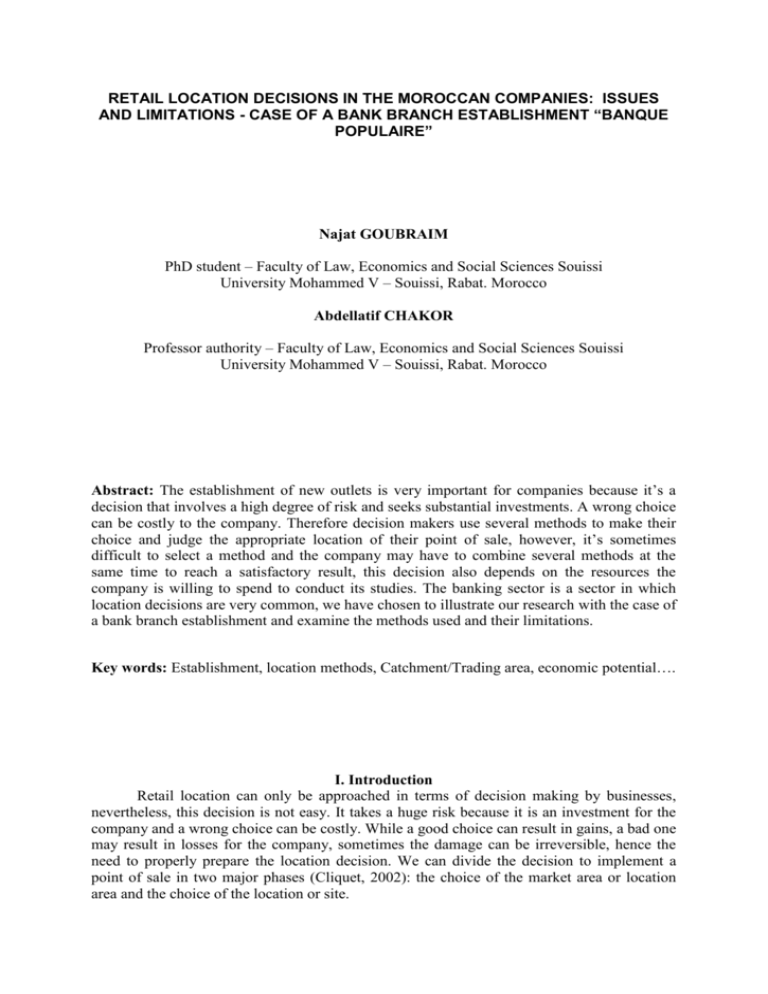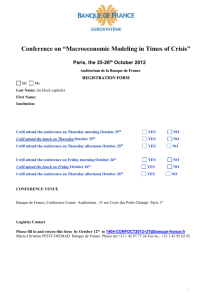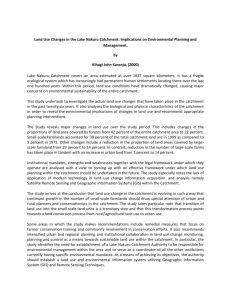RETAIL LOCATION DECISIONS IN THE MOROCCAN COMPANIES
advertisement

RETAIL LOCATION DECISIONS IN THE MOROCCAN COMPANIES: ISSUES AND LIMITATIONS - CASE OF A BANK BRANCH ESTABLISHMENT “BANQUE POPULAIRE” Najat GOUBRAIM PhD student – Faculty of Law, Economics and Social Sciences Souissi University Mohammed V – Souissi, Rabat. Morocco Abdellatif CHAKOR Professor authority – Faculty of Law, Economics and Social Sciences Souissi University Mohammed V – Souissi, Rabat. Morocco Abstract: The establishment of new outlets is very important for companies because it’s a decision that involves a high degree of risk and seeks substantial investments. A wrong choice can be costly to the company. Therefore decision makers use several methods to make their choice and judge the appropriate location of their point of sale, however, it’s sometimes difficult to select a method and the company may have to combine several methods at the same time to reach a satisfactory result, this decision also depends on the resources the company is willing to spend to conduct its studies. The banking sector is a sector in which location decisions are very common, we have chosen to illustrate our research with the case of a bank branch establishment and examine the methods used and their limitations. Key words: Establishment, location methods, Catchment/Trading area, economic potential…. I. Introduction Retail location can only be approached in terms of decision making by businesses, nevertheless, this decision is not easy. It takes a huge risk because it is an investment for the company and a wrong choice can be costly. While a good choice can result in gains, a bad one may result in losses for the company, sometimes the damage can be irreversible, hence the need to properly prepare the location decision. We can divide the decision to implement a point of sale in two major phases (Cliquet, 2002): the choice of the market area or location area and the choice of the location or site. These choices depend on the results of prior studies on the economic potential of the market area, the boundaries of the catchment area and the demand forecast as well as the sales forecast of the future point of sale. The location study of outlets often involves studying the economic and demographic development of an area, analyzing competition, potential customers, detecting underutilized areas... Banking is a rapidly growing sector, in which location decisions are very common, and we have seen a particular interest in illustrating our paper with a case study of the approach adopted by the “Banque Populaire” to make a location study of one of its new branches. “Banque Populaire” is known for its vision to open a hundred branches per year; we therefore considered that this is a good example of illustration. The main purpose of this paper is to study the elements of decision-making aid, related to retail location, through a review of literature outlining all methods used in this respect. Along with this we will also get to learn about the various challenges and limitations of these types of decisions. Finally we will see how these decisions are made in reality through the case of the establishment of a bank branch. II. Retail location methods Retail location methods are very varied and are more or less operational. Several objectives can be pursued through these methods: the definition of the geographical area and forecasting future commercial results of the point of sale. (Cliquet, 2002) According to Cliquet (2002), if the location decision is made in two stages: the market area and the site, the definition of the geographical area (or geographical areas) too is carried out in two stages: the market area and the catchment area. The central place theory (Christaller, 1933) was the first attempt to establish market areas. Based on the perfect rationality of the consumer and an unbounded isotropic homogeneous, limitless surface with an evenly distributed population, this theory leads to the definition of regular market areas (Berry, 1967) and to a hierarchy of centers (for example : cities) according to the services offered. 2.1 Determination of the catchment area According to Lendrevie and Lévy (2012), the catchment area is the area or region from which come the majority of customers of a point of sale (80-90%). It determines the potential clientele and, depending on its purchasing power, the potential market of a point of sale. The determination of the catchment area has been the subject of numerous studies from which Cliquet (2002) drew two sets of methods: a set of methods based essentially on the empirical study of localized data, and another set of methods which are subject to mathematical modeling. Four methods based on the empirical study of localized data are or have been often used: the geographical identification of customers (customer spotting), methods based on a measure of distance, Piatier method (1969), and the budget coefficients method. - The geographical identification of clients (Applebaum, 1996) is done through the examination of plates of vehicles in car parks, through a survey, through checks or through loyalty cards and information that the consumer agrees to assign to the merchant at the time of creation of the card; - The Methods based on a measure of distance are used to draw isochrones (Brunner and Mason, 1968) and are based on the principle that "the true measure of distance" is "the speed of movement of men" (Braudel, 1986); - The Piatier method aims to analyze influence areas (including commercial ones) of the major French cities, but this method is no longer used because it is not practical (Cliquet, 2002); - The method of budget coefficients is based on the measurement of the quotient of the expenditure -dedicated to a good or a service- on the total expenditure. Mathematical modeling has also allowed the development of methods to delineate the catchment areas under certain conditions (Even if there are several methods in this set, we only chose two methods to illustrate it): - The limit point method stems from the idea that "if two centers have the same interest, consumers will choose the closest, but if the centers’ attraction is different the limit point of influence will always approach the less interesting center" (Berry, 1967); - The probabilistic curves are based on the Huff model, the latter brings a solution to the problem of overlapping catchment areas, it provides the probability that a consumer located in a point i moves to a point of sale located in a point j. 2.2 Demand and sales forecasting Demand and sales forecasting is based on certain methods and techniques which include: - The customer spotting (Applebaum, 1966) based on the division of the catchment area into three areas: primary (60% to 70% of turnover), secondary (15% to 25%) and tertiary; The penetration rate or attraction power, represented by the percentages between brackets, allows calculating sales forecasts (provided having the necessary data). - The Ratio sales/surfaces method based on the proportionality between the store market share measured in terms of sales and the one measured in terms of surface; - The Construction of polygons from lines joining the already existing points of sale, helps highlighting the intersections which constitute possible locations; The assumptions of this method are very simple: when you have outlets of same size, similar attraction with undifferentiated products, the accessibility therefore the distance home-store (shop) is regarded as decisive in the choice of the point of sale. III. Location decision The methods we have seen in the first point aim to feed the information system with the required geographic information to constitute a file which will be used later for outlets location. Other methods are intended to help directly in the choice of location. As already mentioned the location decision is divided into two stages: the selection of the market area and the selection of the site or location. 3.1 The selection of the market area The market area is the geographic area in which a product can be marketed. The perimeter of the area is theoretically delimited by the fact that the cost of production of the product added to the cost of transportation shall not exceed the price the consumer is willing to pay. The decision related to the choice of a market area is taken according to the sociodemographic characteristics of the population residing in this area and the potential for expansion of this area. Appreciating the intensity of competition may then contribute to making this decision (Cliquet, 2002). 3.2 The selection of the location The choice of location must meet a number of principles identified by Lewison and Delosier (1986): - The principle of interception: intercept the traffic along the site; - The principle of cumulative attraction: a group of similar businesses create a synergy; - The principle of compatibility: synergy due to complementary businesses; - The principle of accessibility; “how to make the approach, the traffic and the exit easier to the consumer?” - The principle of over-equipment: pay attention to traffic congestion. According to Cliquet (2002) one of the most used methods for choosing a location is the checklist, it consists in listing all the criteria related to each of the principles cited by Lewison and Delosier which concern population, competition, traffic, parking, access, nature of the site, environment and installation conditions. Several regression models were developed especially in the banking sector (Martin, 1967, Clawson 1974, Olsen and Lord 1979). IV. Issues and limitations of location decisions Whatever be the type of business, choosing a good location is surely one of the most important decisions a manager must take. The location of the point of sale is a long term investment and good or bad choices in this regard will be felt on sales, on the market share and on the profitability of the activity in an even more important way when the level of competition is high. The selection of a location is necessarily accompanied, in most cases, by a quantitative and sometimes a qualitative measure of the market potential in the vicinity of the location/locations approached. The reason behind this is not only to decide the use of the most interesting location but also to forecast sales and develop an appropriate marketing strategy (Baray, 2002). One of the major issues in location decisions is the choice and the delimitation of the catchment area (we have seen in the previous paragraphs the methods of choice and delimitation of this area). We have also seen that the retail location implies a triple choice: a market area, a site and a suitable offer. Three types of analysis are used to measure the economic potential of a territory on which the location decision will be based (Douard, 2002): - The demographic analysis which reveals the demographic structure of an area; - The resources analysis based on the population income; - The expenditure analysis based on the breakdown of average household expenditure. But according to Dourad (2002) these methods have different weaknesses. 4.1 Extremely Modelled approaches Demographic phenomenons are regarded as representing a character of permanence and continuity they do not have. Old data is a weakness of this type of approach. The theoretical market appears to be linked to area residents, but traveling for reasons of work, leisure, medical consultation ... has become almost daily in today's population. 4.2 A rationality problem in location decisions The coverage of a territory is done taking into consideration one of the three following elements: competitors, seeking potential areas, or going to areas which are already commercially equipped. The main idea is not to let competitors take root, but the multiplication of similar projects to those already existing in a commercial pole, leads to an overcrowding in terms of location that does not always take into account actual potentials. 4.3 Blurred catchment areas The approach by the catchment area has become complicated today because of the customers’ behavior: customers now move more and are less loyal. Traditional behavioral grids are not enough today to understand the buying behavior. Lifestyles, mobility and geography have become essential dimensions to define a commercial territory. Therefore the concept of catchment area has evolved, it moved from the point of sale to the commercial pole and it now covers a much larger area. 4.4 Flows of consumption analysis Flows of consumption analysis, for an activity or a geographical area suitable to that activity, consists to evaluate the market, the attraction, the current offer, the outshopping and the outshopping structure. The development of behavioral data bases made from large surveys matches this new approach of territory. These data on consumer behavior are taken into account with different descriptive variables of space, resident population and economic locations. The development of analysis tools supported by mapping suggests appropriate approaches in the context of geo-marketing. Now that we have seen the different methods that help in location decision-making from a theoretical point of view as well as the challenges and limitations of such decisions, we will try in the next point to see how this decision is taken in reality through a case study of a bank branch that belongs to “Banque Populaire". V. Case study: the establishment of a bank branch “Banque Populaire” Methodology Our empirical research as already mentioned is based on an exploratory study: a case study. One of the main advantages of the case study, which made us chose it, is the fact that this method allows multiple roundtrips between mobilized theories and field investigation. It does not necessarily force the researcher to adopt a purely deductive approach; conversely, it does not require either to adopt a purely inductive approach. Our case study is based on the following methods of investigation: - Internal and external documentary research: We consulted in detail the documents at our disposal (all secondary data) and internal documents that the company agreed to disclose to us (Market Research, Feasibility Study...). - Conducting interviews: Discussions with few staff members made us understand more about the situation and enrich our case study. 5.1 Presentation of “Banque Populaire” “Credit Populaire du Maroc” (CPM) is a group consisting of “Banque Centrale Populaire” (BCP) and “Banques Populaires Régionales” (BPR) “Banque centrale populaire” is the main bank (the central entity), and “banques populaires régionales” are regional banks. Introduced in Morocco by the Dahir of 25 May 1926, the organizational and business model of the Group is based from the outset on the concepts of mutuality and cooperation. Thus, the first “Banques Populaires” of a cooperative type and of regional vocation, were created in the late 20s of the last century, in the major cities of the Kingdom of Morocco. In the aftermath of independence, the government conducted, in the framework of the implementation of the first milestones of Moroccan banking and financial system, the redesign of “Credit Populaire du Maroc” (CPM) through the Dahir of 28 February 1961, dedicating it to the development of crafts and small and medium-sized enterprise/ small and medium-sized industries (SMEs / SMIs). This reform has also strengthened the organizational model of CPM, now based on the existence of “Banque Populaires Régionales”, a central entity: “Banque Centrale Populaire”, and a unifying body: the Steering Committee of the CPM. True to its entrepreneurial spirit, “Crédit Populaire du Maroc” has set as a goal to support all medium and small businesses (industrial or of services) through the distribution of loans in the short, medium and long term. It offers a broad and a complete range of services and financial products to meet all the needs of its clients. Having the largest network of banking in Morocco, the group opens hundred of branches each year. Table 1: Key indicators of “Banques Populaires Régionales” in 2012 Source: Annual report of activities (2012) of “Groupe Banques Populaires” From the table we can see that the largest number of branches opened in 2012 by the group belong to the regional bank of Rabat-Kénitra (205 branches in 2012), thus we will analyze, in the next section, the location study of a branch belonging to that regional bank. 5.2 Location study of the bank branch RIYAD III The “Banque Populaire” in the location study of its branch RIYAD III has chosen the following process: Table 2: Process followed in the location study of the branch RIYAD III Process followed in the location study of the branch RIYAD III Opportunities Geographical Determination Determination Identification Identification of opening a scope of of the target of the of the of market bank branch action of the market size population economic and needs in in the locality branch and its characteristics social terms of evolution environment of products and the locality banking services 5.2.1 Opportunities of opening a branch in the locality Riyad - The “Banque Populaire” (BP) wanted to expand its branch network in this sector in order to achieve greater market share; - Mark the presence of “Banque Populaire” in the attractiveness area covered by competition branches; - Strengthen the network of branches and consolidate the leadership position in the locality RIYAD1; - Support the growth and expansion of a locality of high demographic potential; - Exploit the existing needs of that locality. The study is the continuity of the establishment efforts of new branches by the “BP” in the RIYAD sector which experiences a constant growth. 5.2.2 Delimitation of the geographical scope of action of the branch Riyad III The perimeter in which the branch Riyad II is situated starts from the street Abderrahim BOUABID and ends more or less towards the sports complex Moulay Abdelah. The location of the branch Riyad III will serve a very dense area of a great importance due to ADDOHA / PRESTIGIA project2. 5.2.3 Determination of the target market size and its evolution Being at the crossroads of several neighborhoods, the location of the new branch is ideal. It is located in a major catchment area with the possibility of single and multiple accesses. The map of this perimeter marks different areas and poles of attraction as well as infrastructure projects. 5.2.4 Determination of the population characteristics The population has a significant and substantial rate of demographic growth. RIYAD encompasses an area in which the distribution of population by age reveals specific types of needs and therefore a customized commercial offer should be established to meet the needs. 5.2.5 Identification of the economic and social environment of the locality In its study of the locality of the branch, the bank could count several units belonging to different sectors of activities : Pharmacies (2) Pastries (1), hairdressing parlors (2), bus lines (2, ligne4/ligne32), pressings (2), mini markets (1) fashion shops (3) library (1), sports grounds (2), Fast food outlets / cafes (3) clinic (1), grocery / butchery (4) and doctors /dentists offices (2). Indicators of wealth: The level and nature of the residents’ income was analyzed, the salary range is large it goes from low salaries (minimum growth wage) to high salaries. Real estate environment: several types of buildings for residential use and commercial use were detected in the locality. Regarding the buildings for residential use, the value of the m2 (square meter) varies from 15 000 dirhams (Dh) to 20 000 Dh depending on the nature of the area. As for commercial buildings, the value of the m2 varies from 50 000Dh to 70 000Dh. Economic environment: The bank has tried to measure the influence of SMEs near major highways on the economic life of this locality. Social environment: nurseries, primary, secondary and high schools, were detected in the locality. 5.2.6 Identification of market needs in terms of banking products and services The needs of this segment of customers are specific and usually revolve around a requirement of a good quality of service and an appropriate advice on investment products, housing loans and consumption loans. 1 2 RIYAD is a prestigious locality in Rabat (capital of Morocco) A prestigious real estate project The product approach is usually only possible for simple products and towards customers belonging to the high-end segments. - The current position of competition on the market of the new branch: The quality of this presence is a reflection of the neighborhood. The competitors’ bank branches are modern and equipped with automatic teller machines with pleasant indoors and a well qualified front office staff that work on preserving the image of the institutions and build customer loyalty. - The position of “Banque Populaire Régionale”on the market of the new branch: The choice to establish a new branch in the locality RYAD will help the BP to target an upscale clientele and thwart the already existing competition in order to expand the portfolio of customers and increase the market share. Conclusion Through its location study to establish its new branch, the “Banque Populaire” found that the studied locality has great opportunities and it indeed represents a relevant choice. As we have seen the BP tried to conduct certain analysis related to the location decision making that were discussed in the theoretical sections of this paper including the demographic analysis, the income analysis and the determination of the catchment area without forgetting certain elements related to competition and to the socio-economic environment of the locality. Nevertheless we may as well conclude that the process followed by the BP in its location study, even if it was methodical, has been done in a simple way and the BP did not use the methods and retail location models properly or thoroughly, some analysis were based on observation only and in no case a geo-marketing study was mentioned. If the process used by the bank to make the decision to establish the new branch was simple and avoided the complexity of some theoretical tools, it is still likely to be prone to errors of judgment. We can nevertheless understand that the use of certain tools such as geo-marketing tools can be expensive, so it is up to banks to decide, according to their resources and objectives, of the tools to use. References Baray J. (2002) Localisation commerciale multiple: une application du traitement du signal et du modèle p-médian au développement d'un réseau de magasins de produits biologiques, thèse en sciences de gestion, université de Rennes I, décembre 2002. 20-21 Baray J. (2010), Géomarketing : zone de chalandise & méthodes d’implantation, EEEA Editions. Cliquet J., Josselin J.M. (2002), Stratégies de localisation des entreprises commerciales et industrielles : de nouvelles perspectives, de Boeck, 40-45 Cliquet J., (1992), Management stratégique des points de vente, Dalloz-Sirey. Douard J. (2002), Le Géomarketing : outils et applications, Editions ESKA, 81-84 Douard J., Heitz M. (2004), Le géomarketing au service de la démarche marketing, Dunod, 86, 94-96 Lendrevie J., Lévy J. (2012), Mercator : Théories et nouvelles pratiques du marketing, 357 Ghosh A., Mclafferty S.L (1987), Location strategies for retail and service firms, Lexington (Mass), Lexington Books.








